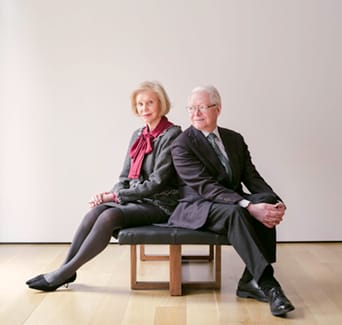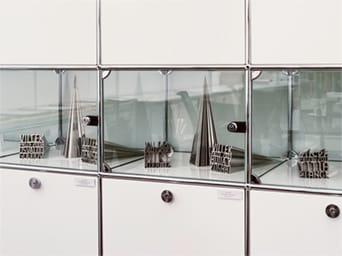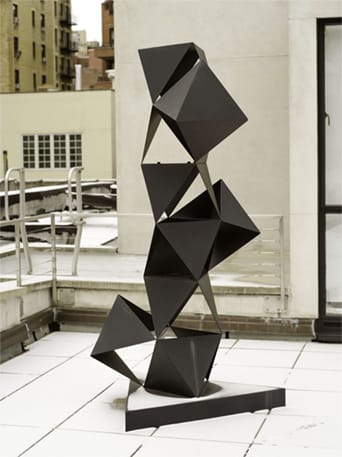
Jan Vilcek, the 80-year-old microbiologist and philanthropist, works on East 73rd Street in Manhattan, three blocks and 4,300 miles away from his home. His current abode is an elegant apartment on Fifth Avenue filled with the works of Georgia O’Keeffe, Stuart Davis, and other American masters, but his homeland is Slovakia, which he escaped 50 years ago.
Vilcek is 5’5” and neat, with silver hair and earnest blue eyes. Today, he wears a crisp pink dress shirt under a burgundy sweater vest in anticipation of Valentine’s Day. He is humble and precise, neither cold nor effusive. His Slovakian accent is as faint as his smile, both of which contain and reveal the unfathomable story of a displaced person who led a miraculous life far from home, and who is now trying to make miracles for other immigrants.
With more than 45 patents to his name, Vilcek is also the coinventor of Remicade. If medicines were hit records, then that anti-inflammatory drug would be Michael Jackson’s Thriller—a hugely popular classic that brings in $8 billion a year. For his scientific research, his compassion for those both similar and different from him, and his philanthropy that enriches the United States, President Barack Obama awarded him the 2013 National Medal of Technology and Innovation. “The medal is in a drawer,” Vilcek says modestly. “It’s not easily framed—it’s on a ribbon.”
In his ninth decade, he has the stamina of his twenty-something staffers. He teaches at New York University ( NYU), publishes research in biomedical journals, and runs the same lab at NYU’s Langone Medical Center that he established in 1965. He is also, with his wife of 52 years—the art historian Marica Vilcek—a humanitarian of uncommon vision and generosity. In 2000, he set aside a percentage of his future Remicade royalties to start the Vilcek Foundation, which supports the work of scientists and artists who have resettled in the United States. “They have a broad sense of rewarding the young people who try new things in science and the arts and who had the opportunity to leave their own country to discover their own identity,” says his friend Christo, the environmental artist who fled Bulgaria in 1956.
The foundation awarded eight prizes this year to foreign-born Americans: four in biomedical science and four in the arts (two Vilcek Prizes of $100,000 each; six Creative Promise prizes of $35,000 each). Whereas the science category is always biomedicine, the arts category changes yearly. The first year, 2006, it was fine arts, followed by architecture, and then classical music, filmmaking, cooking, literature, dance, and contemporary music. This year’s category is design.

After 50 years in America, Vilcek understands how an immigrant’s past and present entwine. Money and time do not erase the never-ending psychic transition from vulnerability to safety. In 1939, when Vilcek was five, Hitler invaded Czechoslovakia, in what is now the Czech Republic. Educated Jews (Vilcek’s mother was an ophthalmologist), the Vilceks hid before the Nazis could send them to die in Poland or Germany. “We were persecuted during World War II,” he explains with great reserve, in the conference room of the foundation. “In 1942, more than two-thirds of Jewish people were taken to concentration camps and most of those people perished,” he says, pausing. “My grandmother was actually sent to a concentration camp in September 1944, and she perished. My mother and I lived with a peasant family who took us in and that’s how we survived. My father joined the uprising against the pro-Nazi government and he managed to literally walk to the front line and join the Russian army.”
The next year, when Vilcek was 11, the war ended, and he and his mother reunited with his father. The Vilceks resumed life in Bratislava under a democratic regime. Three years later, the Communists overtook Slovakia and “people escaped in many different ways.” Living behind the Iron Curtain was restrictive, but Jews could survive if they obeyed orders. “At least we weren’t singled out as enemies or victims,” Vilcek says. “I wasn’t in love with the Communist system, but I could go to study and go to school and get a second degree.” After he graduated from medical school, he earned his PhD from the Institute of Virology at Slovak Academy of Sciences, but could not leave the country and had to turn down a fellowship in London. “I couldn’t go out, but Westerners came in, so I found out what was going on in the rest of the world.”
Marica, too, yearned for freedom. They had met one Easter through a mutual friend. Slender, blond, brainy, and a head taller than him, Marica speaks with a terse tenderness that calls to mind Greta Garbo in Ninotchka. “We met, parted, and that was that,” she says. Soon after, she spotted Jan wandering through the Slovak National Gallery where she worked. That was that. They married in 1962.
Unexpectedly, a scientist invited Jan and Marica to Vienna two years later to see The Magic Flute. There, they decided to defect to West Germany where they applied for, and were granted, U.S. visas as political refugees. “We left illegally,” Marica says. “We didn’t tell my father because the secret police would visit him and it was better for him not to know.”
As traitors, they faced prison sentences if they returned to Slovakia. Jan was sentenced in absentia to five years in prison; Marica got three. “They confiscated our property,” she says. “My brother was sent to the salt mines. That’s how Communism worked—they took it out on your family.”
In 1965, Vilcek set up his lab at NYU and, as he told the New York Times, learned how to apply for this thing called a grant. Cut off from family, dressed in pointy, out-of-style shoes from Hungary, and unaccustomed to basic things like Fahrenheit thermometers, he buried himself in work, seven days a week, which made the transition bearable. “When he got his first paycheck, his shoes went down the garbage dump!” Marica says with a smile.
In an essay about her own migration she wrote: “I was not leaving a supportive family structure or a network of close friends, and I had no feelings of national belonging. Leaving became synonymous with hope, inexplicable and unsure, and oh-so alluring. But as I was soon to discover, rejection is not simply a matter of walking away.”
“We came with nothing as refugees,” Jan says today. “We had some hand-me-downs and nothing of value. We had two suitcases.” Striking out on their own in a foreign country, they found solace in art and science: she at the Metropolitan Museum of Art and he at NYU. Jan’s biomedical research led to the development of a drug for the treatment of inflammatory diseases. Huge royalties followed. Soon they could buy artworks like the ones Marica cataloged at her job at the Met. The couple now owns one of the world’s premier collections of American modernist paintings. “We had more means than we could spend on a comfortable life, so we started to give some back,” Jan says. “Why don’t we recreate our own experience and shape the foundation? We felt happy with the concept and felt we were doing something that was unique and helping the U.S.”
Given his own profession, Vilcek knew that the foundation would fund biomedical science; it took longer to commit to supporting the arts. That’s where Marica came in. An art historian who spoke several languages, she felt most at ease at the Met, where she worked for 32 years, accessioning objects. “The museum was a tight-knit place and I never considered myself an immigrant or a refugee. In the museum, it didn’t matter.” This, combined with a desire to counteract the anti-immigrant sentiment stirred up in the wake of 9/11, formed the impetus of the art prizes.

Sitting at a long table in the foundation’s conference room, Marica, in a navy knit suit and a red silk blouse, exudes a prim businesslike air until she mentions her friends the Christos. “They started every single day at breakfast saying how lucky they were to be living in the United States. They had no money. Once a police car parked in front of their apartment, and they thought they were coming to arrest them. They achieved a tremendous amount coming into this country, with tremendous difficulties in the beginning.”
In 2005, from the window of her apartment, Marica watched The Gates rise in Central Park, a sunrise of orange fabric brightening a city still suffering in the shadow of 9/11. These refugees were healing millions of people with art, much like Jan has done through his scientific research.
The next year, the Vilceks no longer held business meetings at their breakfast table; instead, they bought the townhouse on East 73rd for the foundation headquarters. In an office between Jan’s and Marica’s sits Rick Kinsel, the foundation’s executive director—the literal and conceptual midpoint of science and art. A curator, Kinsel worked with Marica at the Met. Kinsel trained at Bard and the Louvre and is a recipient of the Museum of Arts and Design Visionaries Award. Hyper-attuned to cultural trends, he works on curatorial time, planning future categories four years in advance. He also selects the juries. “I want jurors who go beneath the surface of the field,” he says. “This year we have prize winners who are the future—the bull’s-eye of what design is now and in the future.” Still, he adds, “If two winners are equal in their accomplishments and one had a hard life, we give consideration to that.”
This year’s design winners don’t manufacture stainless-steel-and-leather chairs, or, as Kinsel jokes, objects made from coconut fibers: “We opened the category up and we ended up with winners who crossed genres and didn’t really fit into any traditional categories.” The big winner of the 2014 Vilcek Prize, Neri Oxman, is an Israeli-American who studied medicine and architecture before earning a PhD in design computation from MIT. Her current work at the MIT Media Lab uses patterns and processes found in nature (such as coral reefs) and high-tech digital fabrication (such as 3-D printing) to emulate environmental plasticity. She calls it material ecology. Three other designers won the Vilcek Prize for Creative Promise. Iranian-born media designer Yasaman Hashemian produces video games to combat obesity and help kids cope with ADHD; her empathetic strategies and spirited visual narratives have already garnered support from Michelle Obama. Quilian Riano, an architect from Colombia, uses design, urban planning, and community organizing as a form of international political activism to empower vulnerable populations. And Whirlpool designer Mansour Ourasanah draws on his impoverished childhood in Togo to invent products such as the Lepsis grasshopper breeder, a sleek terrarium that provides protein in the form of edible insects (best consumed de-winged and grilled). In 2025, warns Ourasanah, meat will be a luxury for the rich, and Mother Earth will stop feeding all nine billion of us.
Vilcek is ready for the future. He and Marica have bequeathed a portion of his royalty income and their entire art collection to the foundation, where it will fund dreams as long as the money lasts.
“Marica and Jan themselves embody the very foundations upon which the Vilcek Foundation rests: that sometimes one must leave [home] in order to arrive [home], that cultural diversity can exist only by creating conditions for melting pots, and that speaking different languages can—in the long run—make for better communication,” says Oxman. “So, yes, this recognition moves me and carries with it a strong humanitarian ideology.” Previous winners include the Christos, poet Charles Simic, Mikhail Baryshnikov, cellist Yo-Yo Ma, hip-hop artist Samuel Bazawule, and novelist Téa Obreht, each of whose gifts are too overpoweringly distinct to simply melt or evaporate into a collective culture. “The fantastic initiative of recognizing foreign-born scientists and artists working in the United States was as stunning to me as the fact that my research contributions were being honored,” says 2006 science winner Joan Massagué, director of the Sloan-Kettering Institute. He and Christo attend every awards ceremony, held at the Mandarin Oriental Hotel in midtown.
Later that day, I found Jan sitting in the foundation’s kitchen, quietly eating a sandwich. I asked him about the 2013 National Medal of Technology and Innovation, when he’d had 20 seconds alone with President Obama. What did he say to him? “I told him I was delighted to be getting the prize from him and, as an immigrant, I applaud his effort toward immigration reform and this time I hope he succeeds.”
Jan and Marica show no signs of slowing down. They outpace their young staff with a tireless work ethic; Marica calls it “the immigrant gene.” “I don’t pretend we came with all this,” she says, referring to the great wealth they have accumulated. “This is part of my migration. I didn’t change privately. I understand how we started and how other people start. I never forget.”
Photos by Ross Mantle